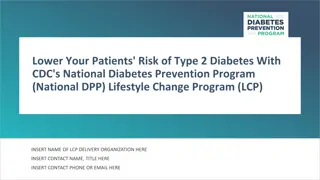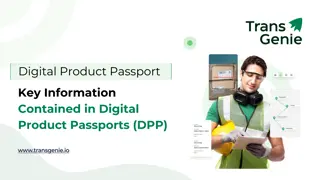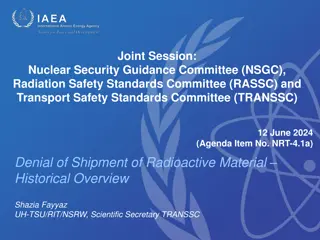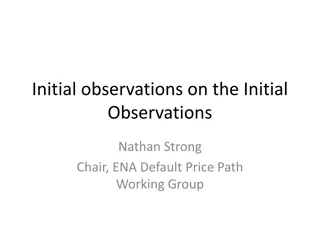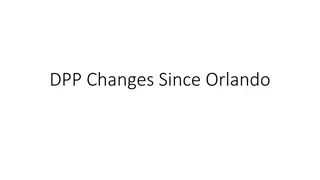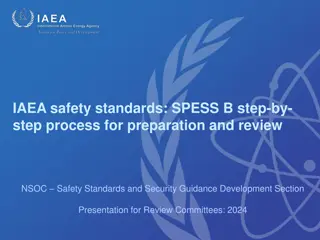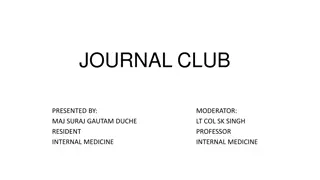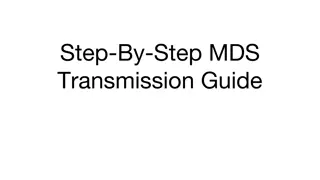
Nuclear Security Recommendations for Radioactive Material Control
Explore the revisions and justifications for the Nuclear Security Recommendations on Nuclear and Other Radioactive Material out of Regulatory Control. Learn about the objectives aimed at strengthening nuclear security regimes globally.
Download Presentation

Please find below an Image/Link to download the presentation.
The content on the website is provided AS IS for your information and personal use only. It may not be sold, licensed, or shared on other websites without obtaining consent from the author. If you encounter any issues during the download, it is possible that the publisher has removed the file from their server.
You are allowed to download the files provided on this website for personal or commercial use, subject to the condition that they are used lawfully. All files are the property of their respective owners.
The content on the website is provided AS IS for your information and personal use only. It may not be sold, licensed, or shared on other websites without obtaining consent from the author.
E N D
Presentation Transcript
NST075. Nuclear Security Recommendations on Nuclear and Other Radioactive Material out of Regulatory Control (revision of NSS No. 15) (Step 3. DPP for approval/clearance) 57th Meeting of the Radiation Safety Standards Committee (RASSC) 09 - 13 December 2024 Ms Itimad SOUFI Ms Itimad SOUFI Division of Nuclear Security Department of Nuclear Safety and Security
Background NSS Fundamentals and NSS Recommendations form the top tier NSS publications; The basis for the national legislative and regulatory framework in many Member States; Review of NSS -15: Consultancy Meeting, March 2020 to conduct a technical review of current publication and assess its continued relevance, adequacy, and any need for revision.
Justification Over a decade since the release of NSS No. 15. (in January 2011) 7 revisions and 29 new publications have been issued within the Nuclear Security Series since 2011 covering areas such as information and computer security, capacity building, risk informed approach, detection in a State s interior, national framework for managing the response to nuclear security events , etc. While the Recommendations remain largely applicable and relevant, there are some areas that require for limited updates to improve its usability.
Objective The current objective of the publication will remain broadly unchanged, as set out in the publication: to provide guidance to States in strengthening their nuclear security regimes, and thereby contributing to an effective global nuclear security framework, by providing: o Recommendations to States and their competent authorities on the establishment or improvement of the capabilities of their nuclear security regimes, for carrying out effective strategies to deter, detect and respond to a criminal act, or an unauthorized act, with nuclear security implications, involving nuclear or other radioactive material that is out of regulatory control; o Recommendations to States in support of international cooperation aimed at ensuring that any nuclear or other radioactive material that is out of regulatory control, whether originating from within the State or from outside that State, is placed under regulatory control and the alleged offenders are, as appropriate, prosecuted or extradited.
Scope (1/3) Broadly remains unchanged; Address inconsistencies with o Fundamentals o Other Recommendations Incorporation of References o IAEA Nuclear Security Fundamentals (NSS No. 20) o Relevant international instruments: Code of Conduct on the Safety and Security of Radioactive Sources International Convention for the Suppression of Acts of Nuclear Terrorism (ICSANT).
Scope (2/3) Consider emphasizing the following topics to account for experience gained during the last decade, as well as developments in the following areas: Information and computer security; Risk-informed and graded approach; New and emerging technologies that could be used to strengthen nuclear security systems; Safety-security interface; National nuclear security detection architecture; Sustainability and resilience of nuclear security regime in unplanned situations for which continuity of operations is needed (e.g., pandemics and natural disasters). Other topics, identified based on the information collected throughout the extensive review process, should be subject to further discussion during the revision process.
Scope (3/3) Consider providing clarification on the following areas: Interface between nuclear security detection and response activities; Nuclear security response to a nuclear security event for materials out of regulatory control (MORC); Criteria and indicators for when material previously under regulatory control is becoming out of regulatory control ; Administrative and technical arrangements to place found, seized, or confiscated material out of regulatory control under appropriate State s control.
Proposed structure The tables of contents for the publication will remain broadly unchanged, as follows: 1. INTRODUCTION 2. OBJECTIVES OF A STATE S NUCLEAR SECURITY REGIME FOR NUCLEAR AND OTHER RADIOACTIVE MATERIAL OUT OF REGULATORY CONTROL 3. A STATE S NUCLEAR SECURITY REGIME FOR NUCLEAR AND OTHER RADIOACTIVE MATERIAL OUT OF REGULATORY CONTROL 4. RECOMMENDATIONS ON PREVENTIVE MEASURES 5. RECOMMENDATIONS ON DETECTION MEASURES 6. RECOMMENDATIONS ON RESPONSE MEASURES 7. RECOMMENDATIONS ON INTERNATIONAL COOPERATION 8. DEFINITIONS
Overview of comments (1/3) Accepted with modification Committee Countries Number of comments Accepted Rejected Brazil (1), Germany (11),Morocco (14), Russian Federation (5), Saudi Arabia (2), Switzerland (5), Ukraine (1) * NSGC 39 5 11 23 RASSC EPReSC TRANSSC NUSSC WASSC TOTAL 4 42 1 6 0 11 3 25 France (3), Ukraine (1)* 8 Member States * Comments match Table of resolutions and updated DPP were posted for information on 22 October 2024
Overview of comments (2/3) Editorial comments (about 20% of total feedback) Accepted / accepted with modification Additional areas for possible enhancement or clarification in the revision process Emphasis on consistency with established legally binding international instruments; Clarification on co-sponsorship, its benefits and associated processes Clarification on updates on the progress of revision Clarification on the interface publications Clarification on the meaning of the term ( resilience )
Overview of comments (3/3) Rejected Suggestions that are not aligned with the established processes or procedures (e.g. content of the DPP); Inclusion of a definition in the DPP; Proposals for new recommendation that are either too specific; Proposals that are already covered by the DPP; Proposal for new terminology; Proposal on the current text of NSS 15, not on the DDP NST 075 (38 % of total feedback)
Action requested The Review Committee is kindly requested to clear or approve the draft DPP, as appropriate, to proceed with drafting. NSGC (lead Review Committee): 3 6 December 2024 CLEARED WASSC: 29 October 1 November 2024 CLEARED EPReSC: 4 November 2024 CLEARED NUSSC: 20 November 2024 CLEARED TRANSSC: 20 November 2024 CLEARED RASSC: 9 13 December 2024 Approval / clearance status:


